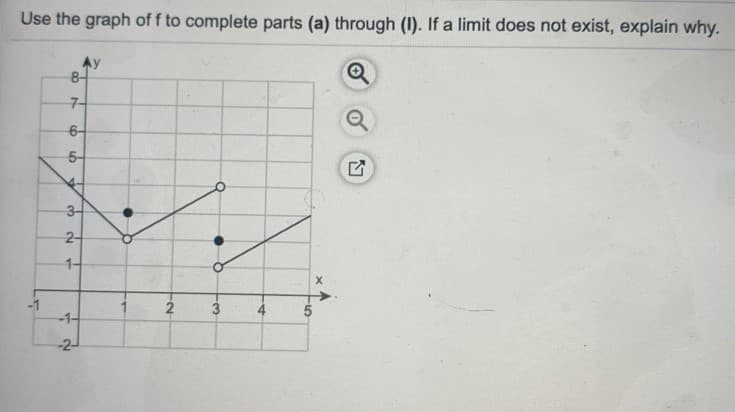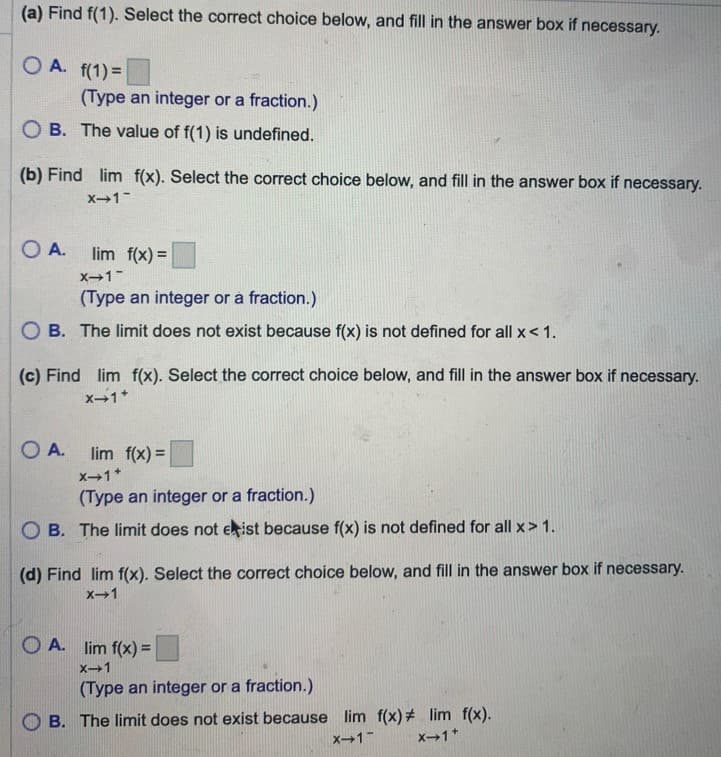Use the graph of f to complete parts (a) through (I). If a limit does not exist, explain why. 8- 6- 5- 3- 1- -1- -2- 4. 2- 7. 2. (a) Find f(1). Select the correct choice below, and fill in the answer box if necessary. O A. f(1)= (Type an integer or a fraction.) O B. The value of f(1) is undefined. (b) Find lim f(x). Select the correct choice below, and fill in the answer box if necessary. X-1- O A. lim f(x) = x-1- (Type an integer or à fraction.) O B. The limit does not exist because f(x) is not defined for all x< 1. (c) Find lim f(x). Select the correct choice below, and fill in the answer box if necessary. x-1* O A. lim f(x) = X-1* (Type an integer or a fraction.) O B. The limit does not eist because f(x) is not defined for all x> 1. (d) Find lim f(x). Select the correct choice below, and fill in the answer box if necessary. x-1 O A. lim f(x) = x-1 (Type an integer or a fraction.) B. The limit does not exist because lim f(x) # lim f(x). X-1* x-1-
Use the graph of f to complete parts (a) through (I). If a limit does not exist, explain why. 8- 6- 5- 3- 1- -1- -2- 4. 2- 7. 2. (a) Find f(1). Select the correct choice below, and fill in the answer box if necessary. O A. f(1)= (Type an integer or a fraction.) O B. The value of f(1) is undefined. (b) Find lim f(x). Select the correct choice below, and fill in the answer box if necessary. X-1- O A. lim f(x) = x-1- (Type an integer or à fraction.) O B. The limit does not exist because f(x) is not defined for all x< 1. (c) Find lim f(x). Select the correct choice below, and fill in the answer box if necessary. x-1* O A. lim f(x) = X-1* (Type an integer or a fraction.) O B. The limit does not eist because f(x) is not defined for all x> 1. (d) Find lim f(x). Select the correct choice below, and fill in the answer box if necessary. x-1 O A. lim f(x) = x-1 (Type an integer or a fraction.) B. The limit does not exist because lim f(x) # lim f(x). X-1* x-1-
Algebra & Trigonometry with Analytic Geometry
13th Edition
ISBN:9781133382119
Author:Swokowski
Publisher:Swokowski
Chapter4: Polynomial And Rational Functions
Section4.1: Polynomial Functions Of Degree Greater Than
Problem 60E
Related questions
Question

Transcribed Image Text:Use the graph of f to complete parts (a) through (I). If a limit does not exist, explain why.
8-
6-
5-
3-
1-
-1-
-2-
4.
2-
7.
2.

Transcribed Image Text:(a) Find f(1). Select the correct choice below, and fill in the answer box if necessary.
O A. f(1)=
(Type an integer or a fraction.)
O B. The value of f(1) is undefined.
(b) Find lim f(x). Select the correct choice below, and fill in the answer box if necessary.
X-1-
O A.
lim f(x) =
x-1-
(Type an integer or à fraction.)
O B. The limit does not exist because f(x) is not defined for all x< 1.
(c) Find lim f(x). Select the correct choice below, and fill in the answer box if necessary.
x-1*
O A.
lim f(x) =
X-1*
(Type an integer or a fraction.)
O B. The limit does not eist because f(x) is not defined for all x> 1.
(d) Find lim f(x). Select the correct choice below, and fill in the answer box if necessary.
x-1
O A.
lim f(x) =
x-1
(Type an integer or a fraction.)
B. The limit does not exist because lim f(x) # lim f(x).
X-1*
x-1-
Expert Solution
This question has been solved!
Explore an expertly crafted, step-by-step solution for a thorough understanding of key concepts.
This is a popular solution!
Trending now
This is a popular solution!
Step by step
Solved in 5 steps with 1 images

Recommended textbooks for you

Algebra & Trigonometry with Analytic Geometry
Algebra
ISBN:
9781133382119
Author:
Swokowski
Publisher:
Cengage

Algebra & Trigonometry with Analytic Geometry
Algebra
ISBN:
9781133382119
Author:
Swokowski
Publisher:
Cengage